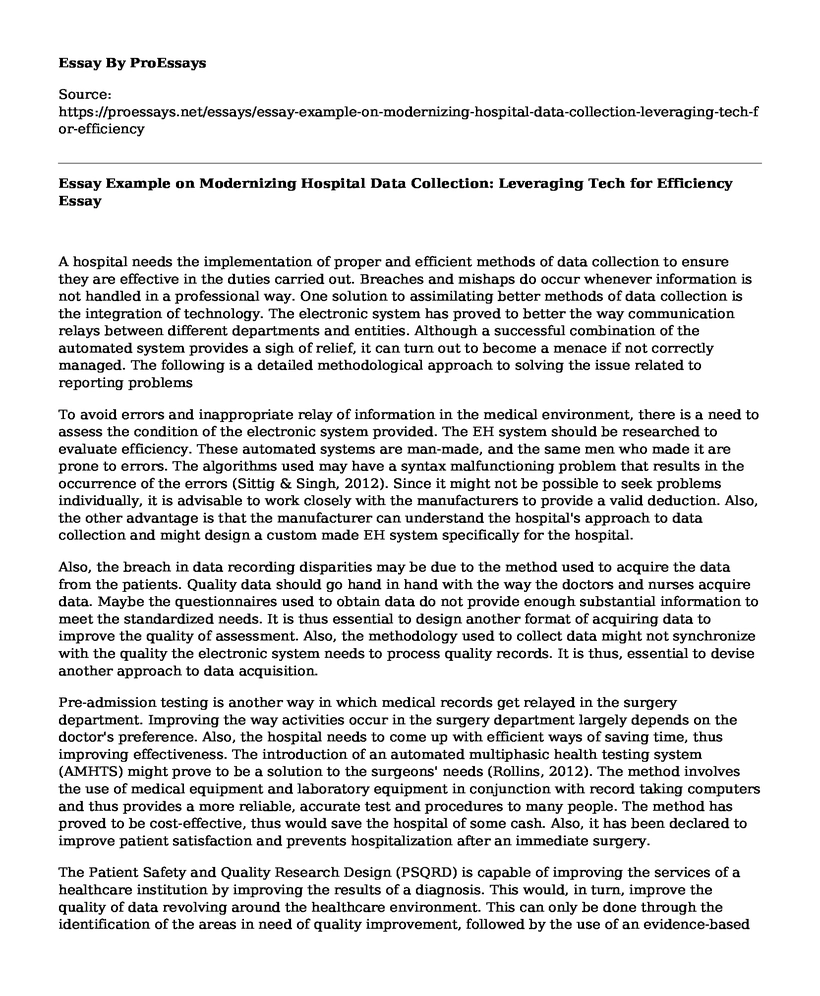A hospital needs the implementation of proper and efficient methods of data collection to ensure they are effective in the duties carried out. Breaches and mishaps do occur whenever information is not handled in a professional way. One solution to assimilating better methods of data collection is the integration of technology. The electronic system has proved to better the way communication relays between different departments and entities. Although a successful combination of the automated system provides a sigh of relief, it can turn out to become a menace if not correctly managed. The following is a detailed methodological approach to solving the issue related to reporting problems
To avoid errors and inappropriate relay of information in the medical environment, there is a need to assess the condition of the electronic system provided. The EH system should be researched to evaluate efficiency. These automated systems are man-made, and the same men who made it are prone to errors. The algorithms used may have a syntax malfunctioning problem that results in the occurrence of the errors (Sittig & Singh, 2012). Since it might not be possible to seek problems individually, it is advisable to work closely with the manufacturers to provide a valid deduction. Also, the other advantage is that the manufacturer can understand the hospital's approach to data collection and might design a custom made EH system specifically for the hospital.
Also, the breach in data recording disparities may be due to the method used to acquire the data from the patients. Quality data should go hand in hand with the way the doctors and nurses acquire data. Maybe the questionnaires used to obtain data do not provide enough substantial information to meet the standardized needs. It is thus essential to design another format of acquiring data to improve the quality of assessment. Also, the methodology used to collect data might not synchronize with the quality the electronic system needs to process quality records. It is thus, essential to devise another approach to data acquisition.
Pre-admission testing is another way in which medical records get relayed in the surgery department. Improving the way activities occur in the surgery department largely depends on the doctor's preference. Also, the hospital needs to come up with efficient ways of saving time, thus improving effectiveness. The introduction of an automated multiphasic health testing system (AMHTS) might prove to be a solution to the surgeons' needs (Rollins, 2012). The method involves the use of medical equipment and laboratory equipment in conjunction with record taking computers and thus provides a more reliable, accurate test and procedures to many people. The method has proved to be cost-effective, thus would save the hospital of some cash. Also, it has been declared to improve patient satisfaction and prevents hospitalization after an immediate surgery.
The Patient Safety and Quality Research Design (PSQRD) is capable of improving the services of a healthcare institution by improving the results of a diagnosis. This would, in turn, improve the quality of data revolving around the healthcare environment. This can only be done through the identification of the areas in need of quality improvement, followed by the use of an evidence-based intervention to provide support to the patients.
The use of two research teams is essential in establishing proof of the findings. Also, if there is a contradiction, further research may bring definite conclusions and even open doors to possible constraints involved. Data needs to be coded using standards. If not so, there would be disparities, and an inappropriate conclusion might be the deduction. It is important to approach the research conclusion statistically, involving all the possible errors that might lead to disparities to overcome such an occurrence.
References
Rollins, G. (2012). Unintended consequences: identifying and mitigating unanticipated issuesin EHR use. Journal of AHIMA, 83(1), 28-32. Retrieved fromhttp://library.ahima.org/xpedio/groups/public/documents/ahima/bok1_049333.hcsp
Sittig, D. F., & Singh, H. (2012). Electronic health records and national patient-safetygoals. The New England journal of medicine, 367(19), 1854. Retrieved fromhttps://www.ncbi.nlm.nih.gov/pmc/articles/PMC3690003/
Cite this page
Essay Example on Modernizing Hospital Data Collection: Leveraging Tech for Efficiency. (2023, Mar 28). Retrieved from https://proessays.net/essays/essay-example-on-modernizing-hospital-data-collection-leveraging-tech-for-efficiency
If you are the original author of this essay and no longer wish to have it published on the ProEssays website, please click below to request its removal:
- Advanced Pharmacology Paper Example
- Effective Communication in Nursing Essay Example
- CIOs: Be Familiar With 4 Unethical AI Issues - Essay Sample
- Essay Sample on Thyroid Disease: Prevalent Health Risk in Adults 35-65
- Paper Sample on Becoming a Psychiatric Nurse Practitioner at Walden College of Nursing
- Client's Readiness for Change: TTM & SDT in Action - Free Paper Example
- Paper Example on Analysis of Prehospital Rapid Sequence Intubation in Emergency Service South Africa







